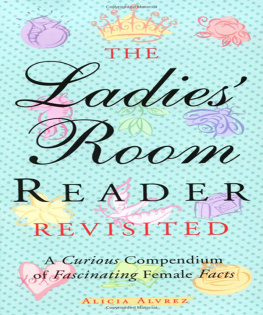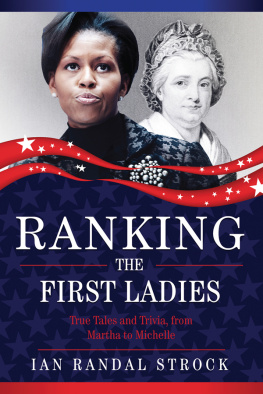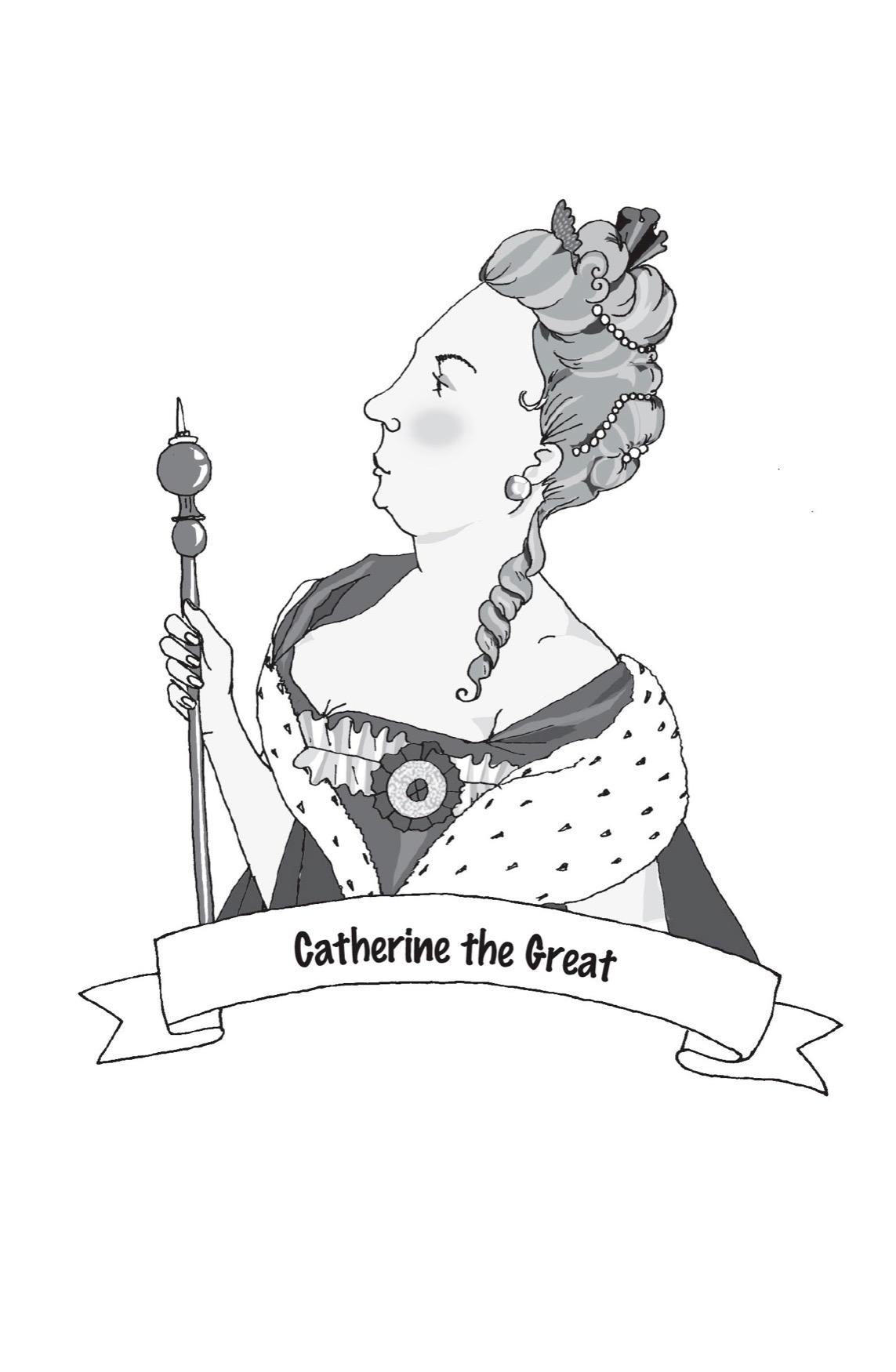W ELCOME to my book about history... wait! Wait, where are you going? Come on back, because Im going to let you in on a secret. Closer, closer... good.
Here goes: dates and battles and charters and treaties are boring. Thats right, I said it! Boring! Fortunately, this isnt a book with dates and battles and charters and treaties, because thats not history.
Nope. History is stories. True stories; better than fiction stories; crazy, incredible stuff-that-actually-happened stories!
Like, did you hear the one about the crazy Russian empress who used doves to set fire to an entire town? Or, how about the fact that court poisoner was an actual job in ancient Rome? Trust me, youre never gonna believe what the Trung sisters got their mom to do.
But youll find out if you turn the page. So lets get to it. Lets go, hurry up! Youre going to flip when you find out more about Ida B. Wells. (Hint: theres biting involved.)
Thanks for reading, and lets go!
Saundra
PUFFIN BOOKS
An imprint of Penguin Random House LLC
375 Hudson Street
New York, New York 10014

First published in the United States of America by Puffin Books, an imprint of Penguin Random House LLC, 2016
Text copyright 2016 by Saundra Mitchell
Illustrations copyright 2016 by Cara Petrus
Penguin supports copyright. Copyright fuels creativity, encourages diverse voices, promotes free speech, and creates a vibrant culture. Thank you for buying an authorized edition of this book and for complying with copyright laws by not reproducing, scanning, or distributing any part of it in any form without permission. You are supporting writers and allowing Penguin to continue to publish books for every reader.
LIBRARY OF CO NGRESS CATALOGING-IN -PUBLICATION DATA
Names: Mitchell, Saundra.
Title: 50 unbelievable women and their fascinating (and true!) stories /
Saundra Mitchell.
Other titles: Fifty unbelievable women and their fascinating (and true!)
stories
Description: New York, New York : Puffin Books, 2016. | Series: They did what? | Includes bibliographical references. | Audience: Grades 4-6. | Audience: Ages 8-12.
Identifiers: LCCN 2015034065| ISBN 9780147518125 (paperback) | ISBN 9780698410992 (e-book)
Subjects: LCSH: WomenBiographyJuvenile literature. | BISAC:
JUVENILE NONFICTION / Girls & Women.
Classification: LCC CT3203 .M615 2016 | DDC 920.72dc23 LC record available at http://lccn.loc.gov/2015034065
eBook ISBN 978-0-14-751812-5
The publisher does not have any control over and does not assume any responsibility for author or third-party websites or their content.
Version_2
This is for Mom, Aunt Mel, Aunt Jinni, Mom Bettis, Ashley, Mom Sally, Donna, LaT, Mrs. Redman, Jane Yolen, Tamora Pierce, and my HLM, Wendi. Thank you for teaching me what it is to be a woman, fearlessly. Love, Saundra.
To my family of strong womenespecially Mom, G-Liz, Aunt Nancy, Aunt Kate, Aunt Chris, Kristin, Hannah, Olivia, and my sister, Jess. And to Dad and Steve, who have loved being surrounded by us. Cara
Catherine the Great
17291796
W ith a nickname like The Great, you know Catherine, Empress of All the Russias must have been pretty impressive.
In fact, she was so impressive that the people of Russia claimed her as their own. Kind of extraordinary, considering that that she wasnt even from there!
Born Sophie Friederike Auguste von Anhalt-Zerbst-Dornburg (say that three times fast!), Catherine was a minor princess in a small country called Prussia. She wasnt even the first or second in line for the throne at home. Instead, she was married off as a pawn to the emperor of Russia, Peter III.
Who, in fact, happened to be German. And really proud of it. Peter wasnt interested in ruling his new kingdom, and he made sure everybody knew it. He refused to learn to speak Russian, couldnt be bothered with the Russian peoples needs, and definitely wasnt interested in learning their culture and heritage.
Stuck married to this snob, Catherine decided to try another way. Instead of blowing off her new country, she embraced it. In her heart, she stopped being Prussian and became Russian.
She changed her name to Ekaterina Alexeievna, which means Catherine, daughter of Alexei. She learned Russian, converted to their church, and got involved in the day-to-day concerns of the Russian people.
The Russians loved her for it. And she loved them. Peter, on the other hand, did exactly the opposite. He was supposed to be in charge, but he was more interested in playing practical jokes, hanging out with his German friends, and deciding disputes in Germanys favor. The Russian people were infuriated.
So Catherine did what she had to do. Fleeing the palace for the safety of the Ismailovsky Regiment, she asked them to protect her from Peter. They escorted her to their barracks, where bishops from the church waited to crown her sole empress of Russia.
Now crowned, and with the force of the military behind her, she arrested her husband. He hadnt wanted to be a Russian emperor, so she made him sign a contract giving up all his rights to the throne.
Mysteriously, he died a few days later. People cant agree if it was suicide or murder, though many were willing to blame it on Empress Catherine!
Now the sole ruler of all the Russias, Catherine started her long, busy reign. She expanded their borders and opened relations with Western Europe and Japan. She built a national school system, including the first school for girls.
Somehow, she also found the time to write comedies and even her own memoirs. She reigned for thirty-four years, the longest rule of any female monarch in Russian history.
Catherine chose to be Russian. She embraced her new country, her new language, and her new peopleand became the greatest (seriously!) empress in their history.
Joan Baez
1941
T here was never any question about it: Joan Baez was going to make her voice heard in the world.
She grew up in an activist family, with two parents who passionately believed in fighting for social justice and civil rights. Dedicated to peace and nonviolence in a time of war, they converted to Quakerism when Baez was young.
Actively campaigning with her parents, Baez realized that her clear, resonating singing voice could spread the message that meant so much to her even farther.
As the United States slipped out of the Korean War and into the fight for African American civil rights at home, Baez and her guitar joined the peace movement.
Her passion for music with a message shone through. Arrested twice for speaking against sending young soldiers to fight in Vietnam, Baez said, I went to jail for eleven days for disturbing the peace. I was trying to disturb the war.
Later, she held a free concert in Washington, D.C. Thirty thousand people turned out to hear her message of peace.
Baez continues to be a musical activist to this day. Shes protested against the death penalty by singing We Shall Overcome at the gates of San Quentin Prison in California.
















